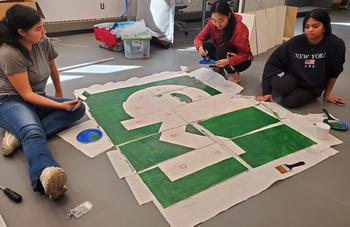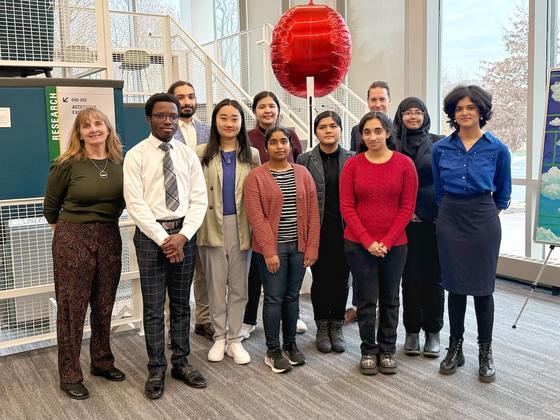The intersection of art and technology has long been a space for innovation, creativity, and exploration. At George Mason University’s Mason Autonomy and Robotics Center (MARC) located within the College of Engineering and Computing, this connection has taken center stage with the Integrating Art and Tech Project. This project brings together students from diverse academic backgrounds to create tech-enhanced artwork that highlights MARC’s cutting-edge research in autonomy, embedded artificial intelligence (AI), and robotics.

The inaugural class began in the fall 2024 semester and met weekly, with artists voluntarily returning on weekends, drawn by the project’s engaging and hands-on nature. Applied computer science major Alexia De Costa, the project’s lead, guided the team of eight students—Irene Hossain, Clarisse Ladaban, Ariel Clemmons, Srikriti Bulusu, Saanvi Munigela, Oluwatomisin Badmus, Adam Alsuezi, and Wanyi Chen (visiting scholar)—who dedicated their time to designing and assembling a collection of interactive artworks.
"Technology has the potential not only to advance autonomous systems, but also to serve as an interactive medium for storytelling and creativity,” said De Costa, who is also an member of the Honors College. "The combination of artistic expression and technological advancement makes the research at MARC more accessible to the public, sparking broader conversations about how these advancements can shape our future."
Their semester-long efforts culminated in an exhibition in December showcasing the innovative projects created through this collaboration.
Exploring the Collection
The collection is divided into three thematic groups: blimps, computer vision, and ground robots, each representing a significant research area at MARC.
Blimps: Bioinspiration in Motion
Lighter-than-air autonomous vehicles are inspired by marine life, including manta rays, stingrays, jellyfish, and sharks. This influence is captured through a lenticular design, where each blimp morphs into its corresponding sea creature as viewers move past the piece. The interactive visual experience reflects MARC’s aerial robotics research and highlights the way bioinspired designs influence technological advancements.

Computer Vision: The Watchful Eye
A moving eye follows the viewer, its pixelated iris symbolizing the computational process behind image recognition and illustrating how AI-powered computer vision perceives the world. Surrounding the eye, a realistic depiction of the sky contrasts with bounding boxes that outline detected clouds—one of which is left undetected to highlight the imperfections and limitations of computer vision technology.
The work draws inspiration from René Magritte’s The False Mirror (1928), creating a thought-provoking commentary on perception and machine learning.
Ground Robots: Interactive Autonomy
Evolved from its original concept of free-moving robots responding to human touch, the final design features a hidden George Mason logo embedded in a maze that illuminates when a viewer is detected. The background features native plant species from the university’s campus, grounding the piece in its natural environment while highlighting the fusion of technology and organic elements.
Supported by the Office of Student Creative Activities and Research (OSCAR) through the Undergraduate Research Scholars Program (URSP), this project benefited from oversight and guidance of MARC codirectors Missy Cummings and Jesse Kirkpatrick to ensure alignment with the center’s research goals.
“This project highlights just how much creative talent exists in George Mason’s College of Engineering and Computing, and also just what student initiative and leadership can accomplish,” said Cummings. “Because of Alexia’s vision, there is now an undergraduate art and technology class that is available to all students.”

Beyond showcasing student ingenuity and dedication, this collaboration between artists and engineers resulted in meaningful outcomes. Additionally, a partnership with World3D allowed the team to produce high-quality prints at a fraction of the typical cost. Pieces that would have cost upwards of $2,500 were fabricated for significantly less, making innovation more accessible.
Exploring New Frontiers in Research
The Integrating Art and Tech Project marks a pivotal step in demonstrating how art can serve as a medium for interpreting and understanding technological advancements. As MARC continues to explore new frontiers in autonomy and AI, initiatives like this will play an essential role in making complex research more tangible and engaging to broader audiences.
“Exemplifying the power of interdisciplinary collaboration, this project demonstrates how engineering and computing merge with artistic expression to create something truly innovative,” said Kirkpatrick. “At MARC, we recognize that autonomy and robotics research aren’t just about advancing technology—they’re about making it impactful, engaging, and meaningful.”
The inaugural class of students has set a remarkable precedent for future cohorts, demonstrating that technology is not only about efficiency and automation—it also has the power to drive innovation in unexpected ways, engage the human experience, and create immersive moments that resonate and inspire.
In This Story
Related Stories
- July 22, 2025
- February 7, 2025
- July 11, 2023
- April 17, 2023
